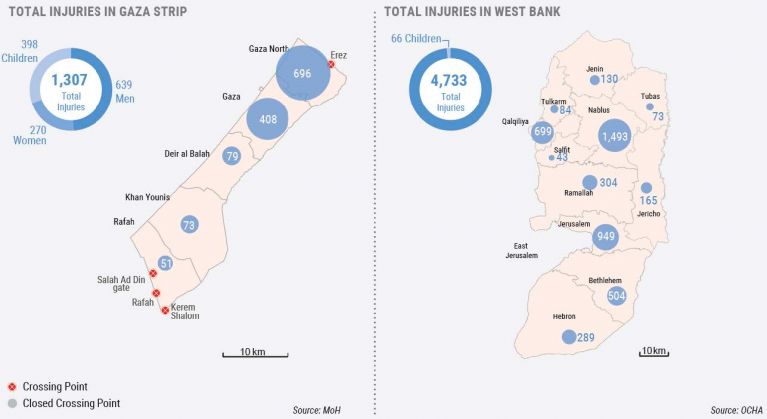Escalation in the Gaza Strip, the West Bank and Israel | Flash Update #7 As of 12:00, 17 May 2021
- Hostilities between Israeli forces and armed groups in Gaza continued for the seventh day, again resulting in casualties. In the last 24 hours, in the context of hostilities in Gaza, the Office of the High Commissioner of Human Rights (OHCHR) verified that 19 Palestinians, including seven children and three women, were killed1. Out of these, at least 10 are civilians.
- Hostilities have also resulted in additional displacement of Palestinians, bringing the cumulative number of internally displaced persons (IDPs) to 58,000, including 42,000 seeking protection in 50 UNRWA schools across Gaza.
- Clashes continued across the West Bank, including in East Jerusalem. Two Palestinians were killed and 440 Palestinians were injured by Israeli forces.
- In Israel, ten people have been killed to date, and hundreds have been injured, based on official data.
- Concerns for the protection of civilians and lack of respect for international humanitarian law persist.
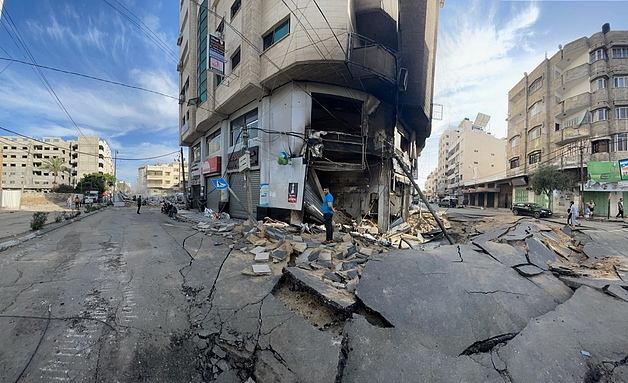
Key asks
The fighting must stop immediately.
Until a ceasefire is reached, all parties must agree to a ‘humanitarian pause’, while Israel should reopen the Kerem Shalom and Erez crossings. These measures would allow humanitarian agencies to carry out relief operations, and people to purchase food and water and seek medical care. Humanitarian Corridors inside Gaza must be agreed to allow movement within Gaza for the delivery of assistance
Situation overview
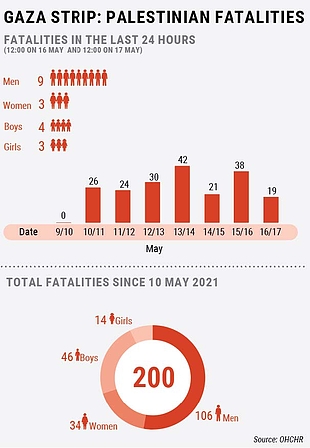 Overnight, Israeli forces carried out strikes on multiple locations across the Gaza Strip, reportedly targeting armed groups and related infrastructure, especially tunnels, and the residences of armed group members. Palestinian armed groups continued extensive firing of rockets and mortars into Israel, with many intercepted by the ‘Iron Dome’ defence system. According to the Israeli authorities, some of the casualties and damage in Gaza may have resulted from Palestinian rockets falling short.
Overnight, Israeli forces carried out strikes on multiple locations across the Gaza Strip, reportedly targeting armed groups and related infrastructure, especially tunnels, and the residences of armed group members. Palestinian armed groups continued extensive firing of rockets and mortars into Israel, with many intercepted by the ‘Iron Dome’ defence system. According to the Israeli authorities, some of the casualties and damage in Gaza may have resulted from Palestinian rockets falling short.
Since 10 May, OHCHR has verified that 200 Palestinians, including 60 children, 34 women (of whom three pregnant) and 106 men, have been killed in Gaza. The overall number includes two people with disabilities, including one a child. According to information available to OHCHR, at least 116 of those killed are civilians.2 At least 189, including 56 children, were seemingly killed by Israeli Defense Forces.
Over 40 people are now estimated to have been killed in a series of airstrikes on residential areas in Gaza city overnight on 15 May, with people unaccounted for and believed to be still trapped under the rubble. The fatalities from these strikes included the head of internal medicine at Shifa, the main hospital in the Gaza Strip, and one of Gaza’s few neurologists, as well as members of their families.
The hostilities have further damaged essential infrastructure, resulting in an additional decline in the public’s access to basic services. According to the Ministry of Public Works and Housing, since the start of the escalation, 132 buildings, comprising 621 housing and commercial units, have been destroyed. In addition, 316 housing units have been severely damaged, and rendered uninhabitable, according to the Shelter Cluster. An additional 206 housing units have suffered major damage, and 6,268 have suffered minor damage.
Power supply across Gaza remains at only 6-8 hours per day, on average, due to damage sustained to a number of feeder lines and networks, disrupting the provision of healthcare and other basic services, including water, hygiene and sanitation (WASH).
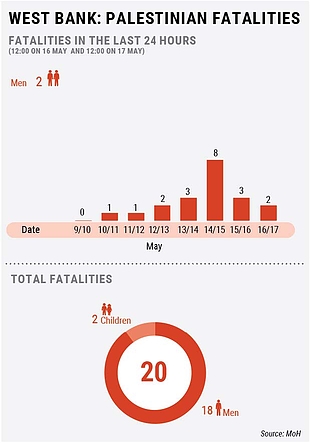 The Education Cluster reports that 47 education facilities, including 42 schools, two kindergartens, an UNRWA vocational training centre, a MoE directorate and a higher education facility have been damaged since the start of the escalation. According to the Health Cluster, six hospitals and nine primary health care centres have been damaged, with one centre suffering severe damage. One hospital is not functioning due to lack of fuel.
The Education Cluster reports that 47 education facilities, including 42 schools, two kindergartens, an UNRWA vocational training centre, a MoE directorate and a higher education facility have been damaged since the start of the escalation. According to the Health Cluster, six hospitals and nine primary health care centres have been damaged, with one centre suffering severe damage. One hospital is not functioning due to lack of fuel.
The hostilities have also increased the number of internally displaced persons (IDPs). According to UNRWA, 42,000 people are present in 50 UNRWA schools, primarily for protection purposes, including 23 designated emergency shelters (DES), still not officially open as such, up from 39,000 people in the previous reporting period. Another 16,000 people are staying with host families.
WASH infrastructure has also been severely affected, including wastewater networks, pipelines, water wells and a wastewater pumping station. The North Gaza Seawater Desalination Plant is still not operational, which undermines the access of about 250,000 people to drinking water. In total, an estimated 800,000 people are lacking regular access to safe piped water.
The Johr Ad Deek landfill area, the main solid waste disposal site in Gaza, has been temporarily closed as a result of bombardment on 15 May, resulting in injury to one municipal employee. Solid waste is now accumulating in a sub-station in the centre of Gaza city, where it may have to be burned pending the reopening of the landfill.
Since 10 May, the Israeli authorities have kept the Erez and Kerem Shalom crossings closed, including for humanitarian aid and personnel. All fishing activity remains prohibited off the Gaza coast. The Rafah crossing with Egypt is open for passengers in both directions as normal. The Salah Ad Din gate has re-opened for the entry of goods.
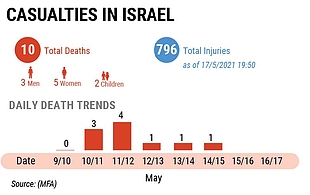 According to Israeli sources, between 10 May and 21:30 on 16 May, Palestinian armed groups in Gaza fired more than 3,100 rockets and other projectiles into Israel. To date, ten people in Israel, including one soldier, have been killed and hundreds have been injured.
According to Israeli sources, between 10 May and 21:30 on 16 May, Palestinian armed groups in Gaza fired more than 3,100 rockets and other projectiles into Israel. To date, ten people in Israel, including one soldier, have been killed and hundreds have been injured.
In the afternoon and evening of 16 May, the West Bank, including East Jerusalem, continued to witness widespread demonstrations and clashes in multiple locations. During the reporting period, two fatalities, and at least 440 injuries, were recorded across the West Bank, including East Jerusalem, bringing the total number of deaths in the West Bank to 20 and the number of injuries to 4.733, since 10 May. The two fatalities include a Palestinian man who was shot and killed after ramming Israeli forces in Sheikh Jarrah, East Jerusalem, injuring seven of them, according to Israeli media, and another Palestinian man who succumbed to injuries sustained from clashes with Israeli forces in Nablus on 15 May. Israeli forces blocked the entrances to the Al Jaouni area of Sheikh Jarrah after the ramming. A heavy Israeli military presence is observed at the main junctions and checkpoints along the main roads of the West Bank.
In East Jerusalem, intensive search-and-arrest operations are being conducted by Israeli forces, involving physical assaults against Palestinians. Attacks against Palestinians by Israeli settlers, were also reported throughout the West Bank, with reports of settlers shooting with automatic weapons at Palestinian residences in Shu’fat and Beit Hanina neighbourhoods of East Jerusalem. One Palestinian who was struck by a stone on Route 60, south of Hebron, on 16 May remains in critical condition.
The national factions in the West Bank have called for a strike on 18 May by merchants, business owners, universities and schools across the West Bank, as well as by Arab communities in Israel. Schools in the West Bank are closed on 16 and 17 May, to prevent students from gathering for demonstration.
Notes
1. Includes those that have died during the past 24 hours due to injuries previously sustained.
2. Those reported as civilians are individualsthat are not members of armed forces and were not directly participating in hostilities at the time that they were killed. Whether an individual is qualified as civilian or not, has no bearing on the legality of the killing. Data is based on information from at least three independent and reliable sources at the time of reporting. As further verified information becomes available, the number of fatalities in total, and in any of the categories, may change.
Humanitarian response & ongoing needs
Protection
West Bank, including East Jerusalem: Cluster partners are monitoring and documenting suspected violations and providing legal aid and child protection services, as well as mental health and psycho-social support (MHPSS). According to the Protection Cluster, of ongoing concern is the persistent excessive use of force by Israeli forces shooting live ammunition towards protestors with a critical number of injuries as a result. Increased tension is reported in East Jerusalem as Israeli forces are using force to disperse peaceful protesters in Sheikh Jarrah and carrying out mass-arrests, following clashes in several areas. Detained children and Human Rights Defenders are receiving legal counselling by cluster partners prior to their interrogation. Since the start of Ramadan on 13 April, at least 67 Palestinian children have been arrested by the Israeli authorities in East Jerusalem. As of 17 May, Cluster partners are planning to resume psycho-social support group sessions for children alongside recreational activities, pending the security situation. Partners are exploring the extended role of existing community emergency protection teams. Of concern is also the continuation of Israeli settler attacks against Palestinians and their homes.
Gaza: The Cluster continues to assess the impact of hostilities on vulnerable groups, by monitoring, documenting, and reporting potential violations of international law. All over Gaza, partners are supporting the provision of assistive devices, physical rehabilitation sessions, and psycho-social first-aid. Partners are preparing medical first-aid kits to distribute to vulnerable families in at-risk areas in consultation with the Shelter Cluster. Remote psycho-social counselling through hotlines and mobile phones and Explosive Remnants of War (ERW) risk-awareness messaging through online platforms and social media are continuing. Online information and emergency-risk education for community members, including for parents or other caregivers on handling stress and caring for children during emergencies, and some specially tailored for people with hearing impairment, are continuing, but effectiveness is undermined by recurrent electricity and internet cuts and across the Gaza Strip. Trauma and psycho-social distress on partners’ frontline staff is reported.
Health
West Bank, including East Jerusalem: As protests and confrontations continue and is widespread across the West Bank, including East Jerusalem, Cluster partners and community volunteers continue to treat a substantial number of injuries, resulting from the use of live ammunition by Israeli forces.
Gaza: Partners maintain their response efforts managing the injured despite very difficult working circumstances. Six hospitals in addition to eight primary healthcare centers sustained partial damages and one MoH primary healthcare centre sustained severe damage. Additionally, one NGO hospital is not functioning due to fuel shortages. The damage to infrastructure is making health facilities less accessible to those in need of medical evacuation and essential health services. Health Cluster indicates that due to long power cuts, there is an urgent need for 400,000 litres of fuel at 33 critical health facilities.
Shelter
Gaza: According to the Ministry of Public Works and Housing, hostilities have resulted in 132 buildings totally destroyed, comprising 621 housing units and commercial facilities, in addition to 384 housing units with severe damage (uninhabitable), 206 with major damage and 6,268 with minor damage. Partners are trying to carry out detailed damage assessments and support the repair of homes with major damage, giving priority to vulnerable groups. According to UNRWA, as of this morning, at least 42,000 people sought shelter in 50 UNRWA schools, including 23 designated emergency shelters (DES), still not officially open as such. Shelter partners have supported at least 512 affected families (2,048 individuals) with Non-food items (NFI), although needs are constantly increasing. Due to damage to power lines and fuel shortages, power supply across Gaza has been reduced to six-eight hours per day on average and in some areas to less than four hours.
Water, Sanitation and Hygiene (WASH)
Gaza: WASH infrastructure has been severely affected, including water and wastewater networks, 15 water wells, a landfill and several equipment and machinery due to damage, lack of power and difficult access. The service provider and the municipalities are currently carrying out some urgent repairs. Some workers were injured while operating or making repairs, requiring ICRC support to rescue them. The North Gaza Seawater Desalination Plant is still not operational and affecting about 250,000 people. In Beit Lahia, sewage and solid waste are accumulating in the streets. Damage to sewage networks is resulting in wastewater flows in the streets in various areas, including Beit Lahia, Gaza city and Khan Younis, and no substantial repairs have taken place yet. Johr Ad-Deek landfill near Gaza city is temporary closed after being affected by hostility, resulting in large solid waste accumulation in the city with possible public health implications. The municipality of Gaza appealed for supporting the provision of municipal services which have been disrupted such as solid waste management, water and sanitation networks. At least 800,000 people do not currently have access to piped water as a result of hostilities. Local authorities reported that it has not been possible to assess any spillage of chemicals and the environmental impact of the largest store for agricultural pesticides in Gaza, which was struck on 16 May, due to security concerns. The WASH Cluster indicates that up to 200,000 litres of fuel are urgently needed to support 109 critical WASH facilities as a result of the long power cuts.
Education
West Bank, including East Jerusalem: The Ministry of Education (MoE) announced the closure of schools in the West Bank, including East Jerusalem, for 16 and 17 May. Students are participating in remote learning for these two days. Cluster partners are scaling up their mental health and psycho-social support (MPHSS) and the monitoring of education-related violations. The MoE will decide today, 17 May, whether schools will re-open.
Gaza: Some 47 education facilities have been affected so far, including 42 schools, two kindergartens, an UNRWA vocational training centre, one MoE directorate building and a higher education facility have been impacted since the start of the escalation with reports indicating that a number were directly hit by airstrikes or tank shells. 50 UNRWA schools have been reportedly used as temporary shelters by displaced people. All schools are closed, and distance learning is not yet activated. Approximately 600,000 students (51 per cent girls) have been losing education time since yesterday. Partners are scaling up remote MHPSS interventions, the delivery of emergency education supplies to displaced children, and will start resource mobilization to rehabilitate damaged education facilities.
Food Security
Gaza: Large agricultural areas and various agricultural facilities such as farms, greenhouses, water wells, have been damaged or disrupted, including at least 2,000 dunums of open field crops and vegetable and 100 dunums of greenhouses, according to the Ministry of Agriculture’s (MoA) estimate, decreasing agricultural production. The situation will be assessed as soon as the situation allows. According to the MoA, due to the closure of Kerem Shalom crossing point, animal fodder stockpile is practically exhausted, and some animal losses have been reported, including 17,000 broilers. Some 600 tons are needed daily to feed poultry and livestock, 1,060 tons (32 truckloads) of privately owned fodder is reportedly stored at Kerem Shalom and ready to be imported.
The MoA warns that this situation directly impacts the food security of 17,000 herding households (85,000 people) and risks disrupting the main protein source of the Gaza population. According to MoA estimates, the reduced quantity and quality of food products will result in an overall loss of US$ 20 million, in addition to US$ 500,000 due to export closure. The ongoing halt of fishing activities is directly affecting 3,600 households.
The World Food Programme (WFP) is monitoring the prices and availability of goods in the markets. The price of basic food and non-food commodities showed a significant increase, with the price of fresh vegetables increasing by 22 per cent in the last two days, due to decreased local production. The need for food and cash support is increasing, and partners have provided at least 56,776 people with immediate assistance through electronic vouchers so far. Partners are continuing to assess the food needs of IDPS.
